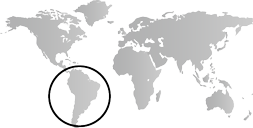The seventeenth century sees the growth of local autonomy and the rise of criollo identities (people of European descent born in the Americas) throughout the Spanish Americas, even as the indigenous population continues its calamitous decline. Writers of noble Inca descent—Garcilaso de la Vega, called “El Inca,” and Felipe Guamán Poma de Ayala—compose revealing chronicles about their disappearing culture. Lima, capital of the Viceroyalty of Peru, grows to become the most important city in the Americas after Mexico, and silver-rich Potosí, the source of the viceroyalty’s wealth, is the fifth most populous city in the world by 1620. Silver production begins a precipitous decline after mid-century but the decimated indigenous population in the central Andean region gradually begins to stabilize, and free-wage labor supplants compulsory labor in the mining districts.
The Peruvian heartland is marked by the political and cultural divisions between Lima on the Pacific coast—nearly 50 percent criollo—and Cuzco, the high Andean seat of Inca civilization, where the population is predominantly native. More than in most other regions of the Spanish empire, the indigenous people of the Andes continue to maintain their Prehispanic ethnic identity, exemplified by the continuation of indigenous arts: the production of traditional Inca woven textiles and emblem-rich wooden utensils called keros. At the same time, missionary activities lead to extensive conversions, as evidenced by the rise of local native cults such as the Virgin of Guápulo (64.164.385), Cocharcas, Belén, and most importantly Copacabana. Elites in Cuzco, both native and criollo, succeed in forging an independent political and cultural identity, separate from both Spain and Lima, a separation that continues into the present.
Peru’s illicit trade with Asia, even after Spain prohibits the Manila Galleons from sailing to Lima (1582) and attempts to stop transhipment of Asian goods from New Spain (1604 onward), is a major breach of Spanish control of the American economy. Still more threatening is the contraband trade with Dutch and English merchants who ply the Atlantic and Caribbean coasts, in competition with the inefficient Spanish monopolies. Persistent attacks by pirates and privateers on the Spanish fleet are a constant concern, as are periodic assaults on major port cities and the permanent seizure of numerous Caribbean islands by rival European powers.
In the eighteenth century, Bourbon reforms—intended to reassert the crown’s control of the colonial economy and to combat these challenges to Atlantic trade—encourage the growth of other important centers in the region encompassed by Peru. Among them are the audiencias of Santa Fé de Bogotá and Quito, both of which develop individual artistic styles, particularly in architecture, painting, sculpture, and silverwork. In 1739, they are permanently consolidated to form the Viceroyalty of New Granada. The audiencia of La Plata, centered in Buenos Aires, a city that has grown up on contraband trade, is elevated to a viceroyalty in 1776. Its situation at the mouth of the River Plate estuary gives Buenos Aires access to the vast interior of the continent and had long provided an illegal Atlantic outlet for the silver of Alto Peru (audiencia of Charcas) around Potosí. This high Andean region is now taken from Peru and incorporated into the new viceroyalty. The loss of Potosí and the rise of Buenos Aires lead to a decline in the importance of Lima in the empire. Much Andean silver is now legally rerouted eastward through La Plata, creating new wealth there and contributing to the development of Buenos Aires as a major urban center more closely oriented toward Europe and neighboring Brazil. There, a new generation of silversmiths, unfettered by the Andean Baroque style, embrace the Rococo fashions recently arrived from Europe. The Neoclassical taste favored by the Enlightenment and post-revolutionary culture of Europe eventually imposes a cool uniformity on the decorative arts throughout the New World, supplanting the distinctive styles that have evolved in the various societies of the Americas.


